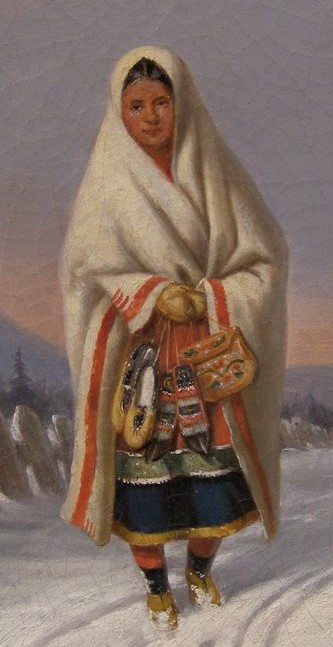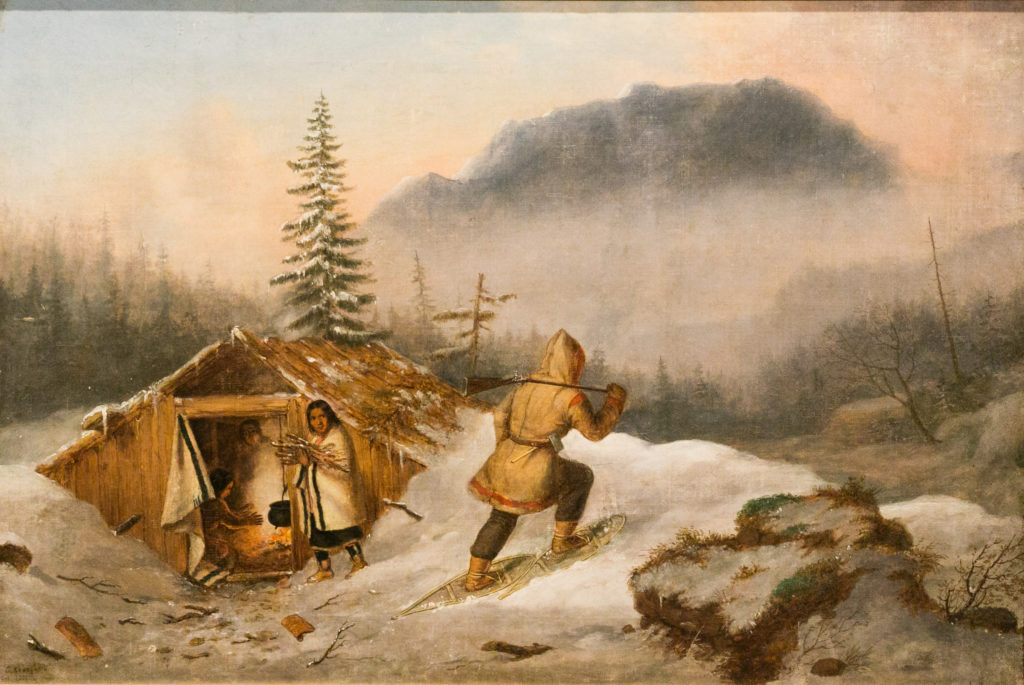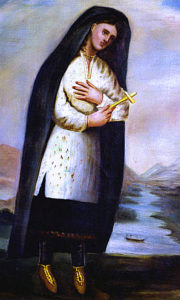Catherine Gandeaktena, the first Kateri
In the Year of Our Lord 1654 an Iroquois army plunged into the Erie homeland, destroying the villages of Gentaienton and Rigué, and reportedly causing so much carnage that the blood ran knee deep in some places.
The survivors fled deep into the woods and all but disappeared from the pages of history, as the triumphant Iroquois returned home with spoils and captives.
 Among these latter was a young Erie woman named Gandeaktena—and it would later be said that the “misfortune of her country proved the blessing of the captive.”
Among these latter was a young Erie woman named Gandeaktena—and it would later be said that the “misfortune of her country proved the blessing of the captive.”
Gandeaktena was adopted into the Oneida nation of the Iroquois and married a fellow captive, a Christian Huron by the name of Francis Xavier Tonsahoten. He was a skilled warrior and hunter, and quite moody and difficult by temperament. Yet as long as lived, he so treasured the memory of his wife that on the occasions when his irascible nature showed itself, he could be calmed in an instant by the mere recollection of her.
In 1667 the Jesuit Jacques Bruyas came to preach to the Oneida. Moved intensely by the Gospel message, Gandeaktena began meeting with the priest for instruction, helped him learn the Iroquois language, and attended chapel regularly.

Her pagan relatives attempted unsuccessfully to dissuade her from Christianity, but they only served to increase her desire to leave Oneida and settle among the French where she could pray in freedom.
So in 1667 Gandeaktena, Francis Xavier, and a little band of seven souls journeyed to the French Canadian settlements over the ice.
In Quebec she was baptized by Bishop Laval, took the name Catherine (or Kateri in Mohawk), then with her husband moved just south of Montreal to help establish a brand new settlement called La Prairie.
From these humble beginnings sprang the great Iroquois mission at Kahnawake which became renowned for its piety and religiousness. So much so that, among the Iroquois, “he has gone to La Prairie,” became an expression of its own, used to mean the man had given up his former vices and was now living as a Christian.
Catherine Gandeaktena’s virtues played no small part in the reputation of the famous mission she founded.

She came to be called by the Indians the “Mother of the Poor”, the “Good Christian” and the “Pillar of the Faith”. Their cabin became a haven for the poor and discontented, and she instructed and catechized many who lived in or passed through the village by the hundreds on the way to the hunting grounds of Canada.
So great a charity beat in her noble heart that her confessor had to prescribe limits to it—she was accustomed to “give the best of what she had, and in a quantity which was even excessive.”
Catherine also established a branch of the newly formed Confraternity of the Holy Family at the mission. Its members were a group of the most devout converts, who said as many as 20 rosaries per day and were the mainstay of the mission’s Catholic life.
After five years of devoted charity, Catherine convinced her husband to give away the last bit of wealth they owned–a belt of wampum beads. They presented themselves before the Blessed Sacrament, where she prayed the following:
“My God, four years ago, I gave to you my body and soul, and the greater portion of my goods. Here is what remains to me; I present it to you with all my heart. What should I now ask of you after having given you my all, unless it be that, from this moment, you take me yourself, to place me near you?”
The very next day Catherine was struck by a headache and fever.
She sensed with joy that the Lord had answered her prayer. Francis Xavier and her other loved ones crowded around her bedside, while the ministering priest had her pray for her own recovery. But she quickly added:
“It has been impossible for me to say from the heart what I have just uttered with the lips. Why ask to remain on earth, since God is calling me to heaven?”
Soon after receiving the last sacraments, Catherine became delirious. Her husband continually exhorted everyone to say rosaries on her behalf, and after 8 days of their “unceasing prayer” she slipped into a final peaceful coma.
Catherine Gandeaktena died to this world on November 6th, 1673.
Her husband distributed all her remaining goods to the poor, asking only for prayers for her soul. It was generally believed, however, by Black Robe and Indian alike, that her soul had attained the final bliss of heaven.

Only a few years later another Catherine, surnamed Tekakwitha, would seek refuge among the devout Christians at the same mission, and her reputation would quickly eclipse that of her predecessor.
But it was the holy example of the first Kateri, Catherine Gandeaktena, that prepared the seed-bed for St. Kateri’s arrival. It was she who founded the mission of Christian Iroquois at Kahnawake, and who prepared the spiritual soil in which the Lily of the Mohawks would bloom.
November 6, 2020








